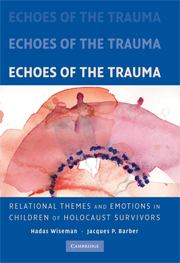Book contents
- Frontmatter
- Contents
- Foreword by Dan Bar-On
- Preface
- Acknowledgments
- 1 Introduction – A Narrative Approach to Bridging the Gap between Clinical Case Studies and Empirical Research on Children of Holocaust Survivors
- 2 Studying Relationship Narratives with the Core Conflictual Relationship Theme Method
- PART ONE RELATIONAL THEMES IN THE NARRATIVES
- PART TWO EMOTIONS IN THE NARRATIVES
- PART THREE HEALING TRAUMA IN THE CHAIN OF THE GENERATIONS
- Appendix
- References
- Index
PART ONE - RELATIONAL THEMES IN THE NARRATIVES
Published online by Cambridge University Press: 29 July 2009
- Frontmatter
- Contents
- Foreword by Dan Bar-On
- Preface
- Acknowledgments
- 1 Introduction – A Narrative Approach to Bridging the Gap between Clinical Case Studies and Empirical Research on Children of Holocaust Survivors
- 2 Studying Relationship Narratives with the Core Conflictual Relationship Theme Method
- PART ONE RELATIONAL THEMES IN THE NARRATIVES
- PART TWO EMOTIONS IN THE NARRATIVES
- PART THREE HEALING TRAUMA IN THE CHAIN OF THE GENERATIONS
- Appendix
- References
- Index
Summary
This part addresses the major relational themes that we identified in the second generation's narratives. Its chapters are arranged according to the three components of the Core Conflictual Relationship Theme method (CCRT). Chapter 3 considers the two major Wishes, namely the wish for closeness and the wish for autonomy. Chapter 4 combines the themes in the three CCRT components that were identified as most prevalent in the narratives of survivors' children about relational encounters with their parents: the need to protect the other (Wish), the other is vulnerable (Response from Other – RO), and in response to the other the self avoids conflicts (Response of Self – RS). Chapter 5, which ends Part One, goes beyond the identification of the CCRT components of the previous chapters to cover the themes of intergenerational communication of trauma expressed in the narratives. The identified patterns of familial communication of trauma provide the context for understanding the emotions in the narratives that are presented in Part Two.
- Type
- Chapter
- Information
- Echoes of the TraumaRelational Themes and Emotions in Children of Holocaust Survivors, pp. 25 - 26Publisher: Cambridge University PressPrint publication year: 2008

